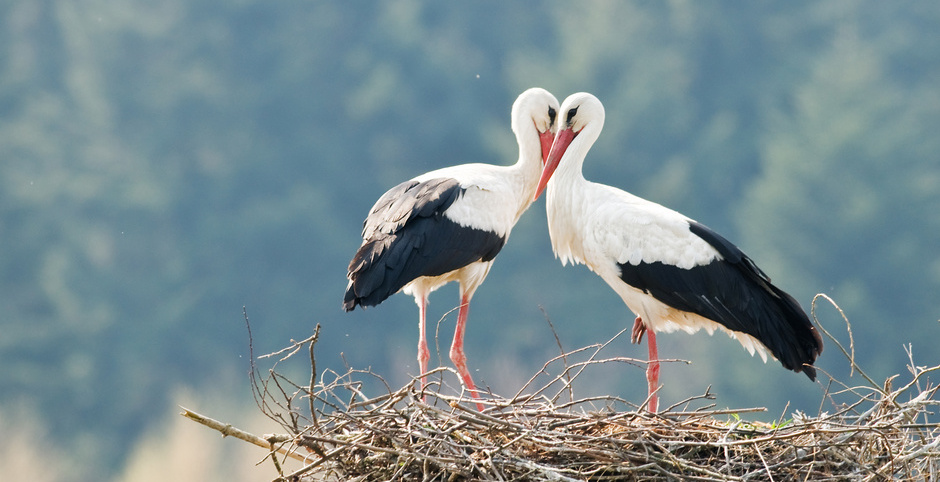
The relationship between partners, filled with care, signs of attention and empathy, poets call love, but biologists - an inter-sexual relationship aimed at survival and procreation. Some species prefer to take in quantity - to breed with as many partners as possible in order to increase offspring, thereby increasing the chances of survival of the whole species. Others create monogamous couples that can cease to exist only after the death of one of the partners. For many years, scientists believed that the first option is much more profitable, but this is not entirely true. Monogamous couples, as a rule, jointly raise offspring, i.e. protect him from predators, get food and learn certain skills, while in polygamous relationships all this most often lies on the fragile shoulders of females. Of course, there are exceptions, but today is not about them. For a long time, biologists were interested in another interesting moment - males continue to show signs of attention to females, even when their pair is already formed and exists for several years. What is the reason for this behavior, what are the benefits of this and what are the evolutionary aspects associated with this? We will find answers to these questions in the report of the research group. Go.
Study basis
Given the subject of the study, we will not focus on polygamous species of birds, but focus on feathered romantics who fall in love once and for all.
Speaking of monogamy, it is worth noting that there are several types of it, depending on the duration: one season, several years, and for life.
Among birds, seasonal monogamy is the most common. A striking example is wild geese. Females are engaged in nesting and hatching eggs, and the male is guarding the territory. On the second day after hatching, the family leaves for the nearest body of water, where goslings learn to seek food for themselves. In case of danger overtaking on the water, the female violently protects the offspring, but the male, apparently remembering about important matters, is most often fleeing. Not the most ideal relationship, anyway.
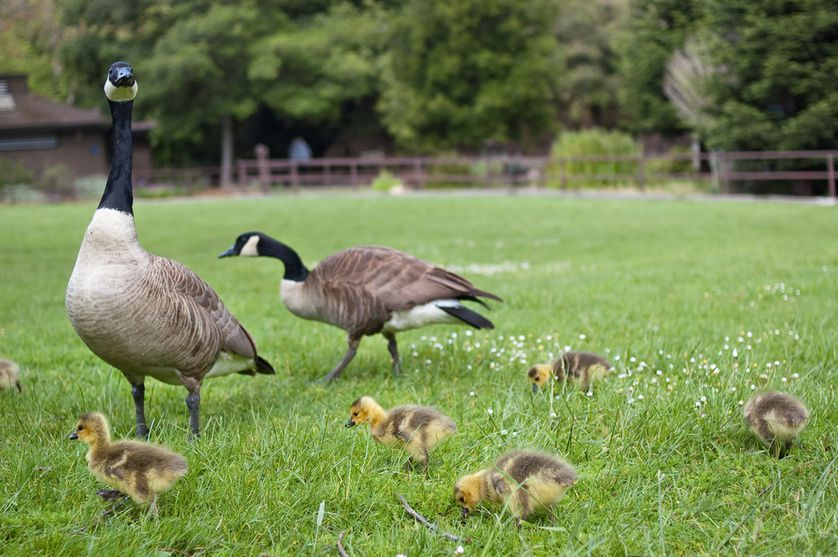
Family of wild geese.
If we talk about relationships, the basis of which is constancy, then storks are the best in this matter. They create a monogamous couple for life and do not even change their place of residence without special need. One nest of storks, which can weigh up to 250 kg and reach 1.5 m in diameter, serves them for many years if natural disasters or human intervention does not destroy it. In the Czech Republic there is a nest that was created back in 1864.

The building skills of storks do not need to be evaluated when you see such structures.
Unlike wild geese, storks have equal responsibilities: both partners hatch eggs, seek food, teach offspring to fly and protect it from dangers. An important role in the relations of storks is played by various kinds of rituals: singing, dancing, etc. The most interesting thing is that these rituals are carried out not only during the formation of the couple (on the first date), but also throughout their life together (even replacing the female during the hatching, the male performs a small dance). For us, it looks very nice, romantic and absolutely illogical, since from a biological point of view such behavior has no benefit. It is so? And here you can smoothly begin to consider the study itself, which was supposed to answer this question.
Ethologists * believe that the constant manifestation by males of their feelings is associated with the preservation of the reproductive state in females.
Ethology * - a science that studies genetically determined behavior, i.e. instincts.At the same time, it remains unclear why such behavior lasts not only during the initial mating period, but throughout life, because it would be more logical for males to invest more strength and energy in offspring, rather than in demonstrating feelings for the female. To date, many researchers believed that the intensity of expression of affection for the female directly affects the quality of mating and, consequently, the offspring (i.e. the number of eggs laid).
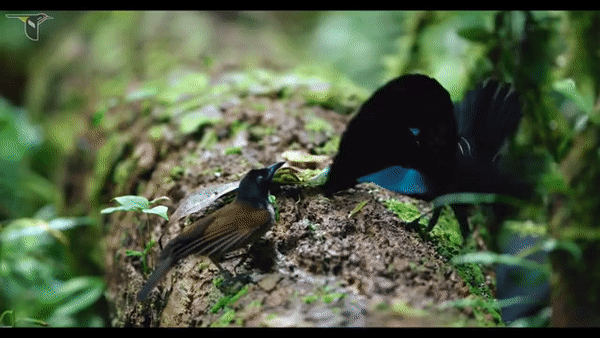
A male of one of the species of birds of paradise dances in front of a female. As we see, the male looks much brighter than the female.
This theory is confirmed by observations. The female, whose partner is an unwritten handsome man and the first flyer in the village, puts more effort into the offspring than if the male is neither fish nor meat. It sounds funny and funny, but the rituals that the males perform in front of the females are aimed at demonstrating not only beauty, but also strength. It just so happened that the bright plumage, beautiful singing and other manifestations of attention on the part of the males are for the females only cognitive signals that it decodes into information about the male.
Scientists from the universities of North Carolina and Chicago, whose work we are considering today, believe that such behavior of males is aimed at optimizing the behavior of females in relation to the process of breeding.
The model proposed by scientists is based on numerous experiments, which showed that amplification of these signals by males increases the contribution of females to the process of procreation. There is an assumption that the source of such stimulating effects are perceptual responses arising from the properties of the environment, signals and the nervous system as such. Currently, about 100 examples of such “deviations” from conventional sensory systems (hearing, vision and smell) are known.
When a male once again demonstrates its advantages over other males, this can positively affect the male himself (the female will choose him for sure). But for the female, this can be a minus, as this will reduce future reproductive implementation. In other words, we have a “exceed expectations” situation. The male, which is much better than other males and constantly shows signs of interest in the female, will receive the desired - mating and procreation, or rather a kind. A female, expecting similar behavior from other males, but not receiving it, may find herself in a deplorable situation. A similar case is called by scientists as an inter-sexual conflict: the demonstration by males of beautiful ones increases among the population, and among females resistance to this tactic grows.
This conflict was modeled using a computational approach (neural networks). In the obtained models, the signaling device (signal source - male) uses the perceptual perception of the receiver (signal receiver - female), which stimulates the signals themselves to the detriment of perception. At a certain moment, a change in the perception of signals in the female population occurs (a kind of mutation), from which the strength of the source (male) signals will greatly decrease. A gradual increase in such changes will lead to the fact that a particular type of signal will be completely ineffective. As such changes take place, some signals disappear, losing their strength, but new ones appear, and the process begins anew.
This very twisted system is quite simple in practice. Imagine that a male appeared with a bright feather (one single), he stands out from the others, and the females give preference to him. Then a male appears with two bright feathers, then with three, etc. But the strength of such a signal, in view of its growth and propagation, begins to fall proportionally. And then suddenly a male appears who knows how to sing beautifully and build nests. As a result, the beautiful plumage as a signal ceases to be effective and begins to degenerate.
However, there is always an exception to the rule - some inter-sexual conflicts can develop into a full-fledged and very effective inter-sexual cooperation.
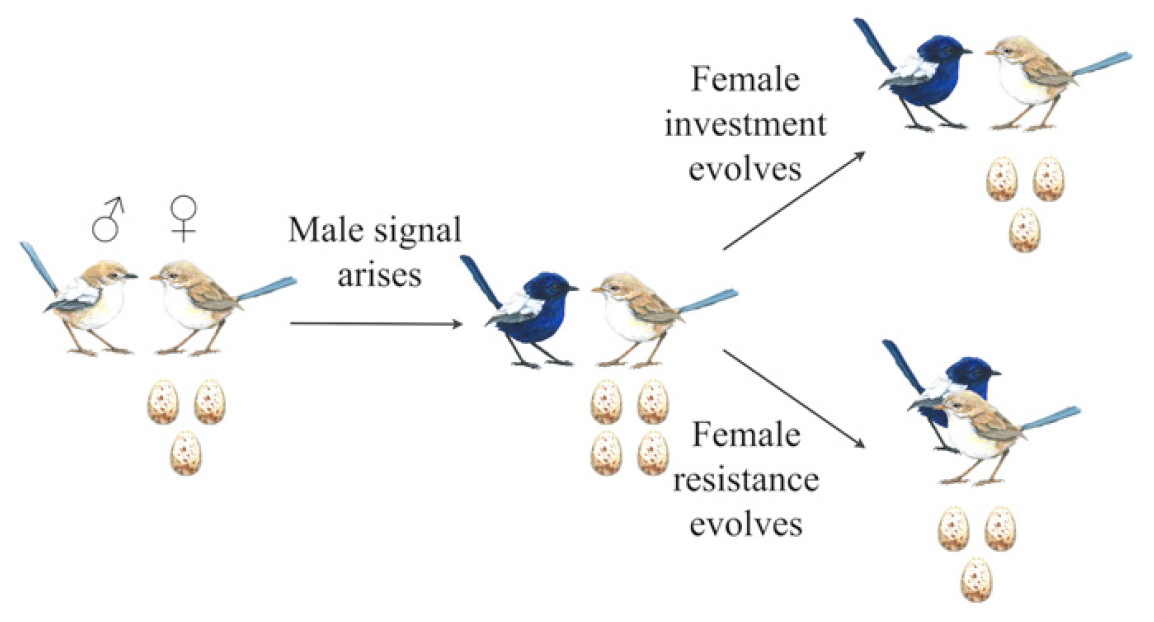
Scheme of the occurrence of inter-sexual conflict and inter-sexual cooperation.
The bottom line is that the male with a more pronounced signal forces the female to lay not three eggs, but four. This is good for the male - he will have more offspring with his gene pool. For a female - not really, because she will have to spend more effort on ensuring that all offspring survive and reach an independent age. Consequently, females begin to develop parallel to males in order to be more resistant to their signals. The result can be two ways: conflict or cooperation.
In the case of cooperation, the females evolve in such a way as to lay 3 eggs, as before the appearance of a stronger signal from the males, but continue to respond to these signals. Here you have women's tricks in the natural world. Thus, not just a pair is formed, but a pair that supports each other at the optimal level for procreation in terms of signal-response interaction.
Males cannot evolve back, roughly speaking. Their amplified signals to the females give the result in the form of a masonry of three eggs, i.e. not as expected. However, reducing the signal to the previous level will also be ineffective, as it will lead to a decrease in the number of eggs in the clutch to two. It turns out a vicious circle - the males cannot reduce the signal strength and cannot increase it, since the females in the first case will give less offspring, and in the second they will not respond.
Naturally, neither males nor females have any malicious intent or desire to enslave each other. This whole process takes place at the genetic level and is aimed solely for the benefit of the offspring of a single pair and the well-being of the species as a whole.
Research results
Using mathematical modeling, scientists evaluated the conditions under which inter-gender cooperation may occur. A quantitative characteristic with an average value of z f describes the main contribution of the female to her offspring. Initially, the average value is allowed to develop to its optimal value z opt , which depends on two variables: the benefit of the contribution (the number of surviving offspring) and the cost of the contribution for the females ( c f ). The last variable is estimated after breeding, implying that some of the females survive and can produce offspring again next year, which leads to an increase in the number of generations.
In this study, several terms will often be used that are worth a little clarification:
- signals - the manifestation of attention on the part of the males to the partners-females (singing, dancing and other rituals) taking place in the formed pairs;
- contribution / investment - the response of females to these signals, manifested in the form of a greater number of eggs in the clutch, more time to care for future offspring, etc .;
- respondent - female responding to male signals;
- costs - the cost of the contribution of the females to the offspring (time in the nest, time to search for food, health status due to the larger / smaller number of eggs in the clutch, etc.).
New male signals and female responses to them were modeled by freely recombining diallyl single-locus modifiers, thereby combining quantitative and population genetic approaches. At the locus * , which controls the response of the female (A), initially a high frequency of the responder allele * (A2) is observed, which corresponds to the previously existing perceptual perception
Locus * - location of a specific gene on the genetic map of the chromosome.The signal locus (B) is initially fixed for the allele without signal (B1). Then the B2 allele is introduced, which causes the appearance of signals from the males.
Alleles * are different forms of the same gene located at the same loci of homologous chromosomes. Alleles determine the path of development of a particular trait.
The responder gene * (Rsp) is a gene that is functionally associated with a segregation disorder factor (SD gene), the active allele of which (Rsp +) is able to suppress the expression of SD.
The manifestation of signals for males also has a price ( s m ), but increases the contribution of the female partner (A2) by α. For example, α can be expressed as an additional egg in the clutch. Moreover, an increase in the female’s contribution can also manifest itself in the form of the positive effects that she exerts on her offspring.
Therefore, the pair in which the male carries the signaling allele and the female carries the responder allele (i.e., pairs A2B2) has an additional contribution from the female and, therefore, is more fertile than the other 3 combinations.

Variants of combinations of males and females by the ratio of signals and responses to them.
The number of offspring that survived for breeding in the next year is affected by the dependence on density * inside the brood and the dependence on the density of the brood after plumage.
Density-dependent * - Density -dependent processes occur when population growth rates are controlled by the density of that population.Another group of variables is associated with the mortality of females and males after the birth of offspring. These variables are determined by the contribution to the brood ( c m is the contribution of males, c f is the contribution of females), signal costs for males ( s m ) and non-selective mortality ( d m are males and d f are females).
Widows, widowers, minors, and any previously single individuals join together to form new couples, and the annual cycle ends. In the studied model, emphasis is placed on genetic monogamy, therefore all types of sexual selection (i.e. competition between individuals for a partner) are excluded from the calculations.

The relationship between the evolution of signals, respondents and input.
Modeling showed that a steady balance is achieved when the males give signals, and the females respond to them. In equilibrium, the entire contribution to the offspring is restored to the level that was before the appearance of additional signals of males.
Figure A above shows an example of evolutionary dynamics, where the contribution of females to the offspring returns to the optimal level, which is the result of the evolution of the quantitative character of the contribution (the dashed green line is the real contribution, and the solid green line is the contribution that was not realized due to the lack of response females for additional signals of males). Chart B shows an alternative example where inter-gender conflict leads to the loss of the respondent.
And on graph C, two parameters are selected that affect this result: an increase in the contribution caused by additional signals ( α ), and the costs of the females for this contribution ( c f ). In the red area on the chart, the signals never increase, since their value will exceed the profit. In the yellow and black areas, the signal frequency increases, which leads to an increase in costly investments on the part of females. In the yellow region, the answer to this is by reducing the quantitative investment trait, which leads to constant fixation of alleles of both signals and respondents. In the black region, where reacting females have more induced investments, the corresponding allele is quickly lost, followed by signals, as in traditional models of inter-genital conflict (Figure B ).
The vertical border between the red and yellow regions represents the point at which the males receive an additional contribution to the offspring due to the fact that the females balance the costs of their signal production. The horizontal border separating the yellow and black regions from the red appears similarly, but for a less obvious reason. When the costs of the females for the contribution ( c f ) are low, the optimal value of the contribution ( z opt ) will be relatively high, and therefore, the contribution of the females will be much larger in the initial conditions. The consequence of this is that the signals give the male a proportionately smaller benefit from the contribution that he causes, which again is offset by his costs.
The parameter space in which signals and responses are fixed (yellow) varies depending on the strength of selection and the genetic dispersion of the respondent allele. For example, when the initial frequency of the respondent allele is 0.9 instead of 0.99, shown in image No. 2, the introduction of signals leads to a more effective selection for responders (the initial genetic variance is higher), and the black region expands to the left.
Male signals can appear even if they involve costs that reduce the male’s contribution to the current brood (parameterized by s fec ), thereby directly affecting the fitness * of both the male and the female, rather than reducing the probability of male survival.
Fitness * - the ability to reproduce individuals with a certain genotype.
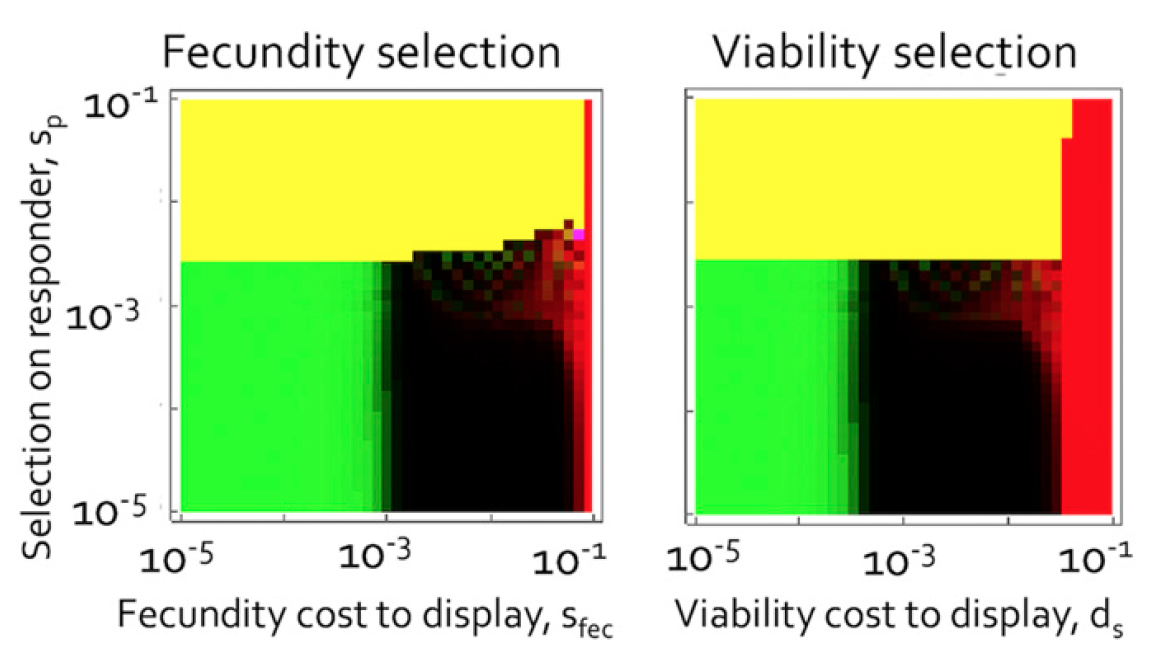
The ratio of costs of fertility and signals (left) and the ratio of costs of vitality and signals.
In the aspect of fertility, when the male signals are fixed (yellow area), all males put less into the offspring than before the signals appeared. In this case, the contribution of the females will be greater than it was before the manifestation of the signals of the males.
The greater contribution of females, when the costs of males are regulated by fecundity (rather than viability), increase the average number of offspring per couple, but this does not fully compensate. Over time, the greater contribution of females leads to an increase in the average number of offspring that have reached plumage, but decreases the average viability of females. This leads to the formation of a new balance between these two forces, where the average number of offspring is lower than in the case of normal viability or in the initial conditions (before the manifestation of signals).
From a mathematical point of view, this is as follows: if the signals of males increase fertility by 1% (but do not increase viability), then the costs of females for offspring increase by 1.3%, but their mortality also increases by 0.5%, and the number of offspring per pair decreases by 0.16%.
If the average value of the contribution of the females is initially lower than the optimal level (for example, due to the influence of the environment), then when a signal stimulating the growth of costs appears, a balanced system arises, i.e. inter-gender cooperation. In such a situation, the signals of males not only increase the contribution of females to offspring, but also their fitness.
Such behavior of males and females most often occurs due to external changes (climate, habitat, amount of available food, etc.). In view of this, scientists suggest that the formation of monogamy in some modern species, while their ancestors were polygamous, is due to migration and, accordingly, a change in the environment.
For a more detailed acquaintance with the nuances of the study, I recommend that you look into the report of scientists and additional materials to it.
Epilogue
This study demonstrated the relationship between polygamy and monogamy in terms of evolution. In the bird kingdom, males always tried to surpass each other in order to get the female's attention: with bright plumage, beautiful dance, or even a demonstration of their building abilities. This behavior is due to competition among males, which is inherent in polygamous species, most often. From the position of females, all these signals make it possible to evaluate the qualities of the male that their common offspring will inherit. However, over time, males began to evolve in such a way that their signals were brighter than those of competitors. Females, in turn, have evolved in such a way as to counteract such signals. After all, there must always be a balance. If the costs of the females for the offspring are disproportionate to the profit, then there is no point in increasing the costs. It is better to lay 3 eggs and survive in the process of hatching and raising offspring than to lay down five and die trying to protect them.
Such an inter-gender conflict of interest could lead to a catastrophic decline in the population, but evolution has taken a more robust path - the path of cooperation. In monogamous pairs, males continue to show themselves in all their glory, and females respond to this with an optimal contribution to the offspring.
It is curious that the world of wild animals is not burdened with moral principles, laws and norms, and all actions are due to evolution, genetics and the thirst for procreation.
Perhaps for the romantics such a scientific explanation of winged love seems too prosaic, but scientists believe otherwise. After all, what could be more beautiful than evolving in such a way that there is a balance and a true partnership between the female and the male, taking into account the interests of both sides and aimed at the benefit of future generations.
Friday off-top:
Despite the fact that the name of these birds is not the most beautiful ("grebe"), their reunion dance is simply beautiful.
Despite the fact that the name of these birds is not the most beautiful ("grebe"), their reunion dance is simply beautiful.
Off Top 2.0:
Birds of Paradise are a striking (literally) example of the diversity of signals males send to females during the breeding season (BBC Earth, voice-over - David Attenborough).
Birds of Paradise are a striking (literally) example of the diversity of signals males send to females during the breeding season (BBC Earth, voice-over - David Attenborough).
Thank you for your attention, stay curious and have a great weekend everyone, guys! :)
Thank you for staying with us. Do you like our articles? Want to see more interesting materials? Support us by placing an order or recommending it to your friends, a 30% discount for Habr users on a unique analog entry-level server that we invented for you: The whole truth about VPS (KVM) E5-2650 v4 (6 Cores) 10GB DDR4 240GB SSD 1Gbps from $ 20 or how to divide the server? (options are available with RAID1 and RAID10, up to 24 cores and up to 40GB DDR4).
Dell R730xd 2 times cheaper? Only we have 2 x Intel TetraDeca-Core Xeon 2x E5-2697v3 2.6GHz 14C 64GB DDR4 4x960GB SSD 1Gbps 100 TV from $ 199 in the Netherlands! Dell R420 - 2x E5-2430 2.2Ghz 6C 128GB DDR3 2x960GB SSD 1Gbps 100TB - from $ 99! Read about How to Build Infrastructure Bldg. class c using Dell R730xd E5-2650 v4 servers costing 9,000 euros for a penny?